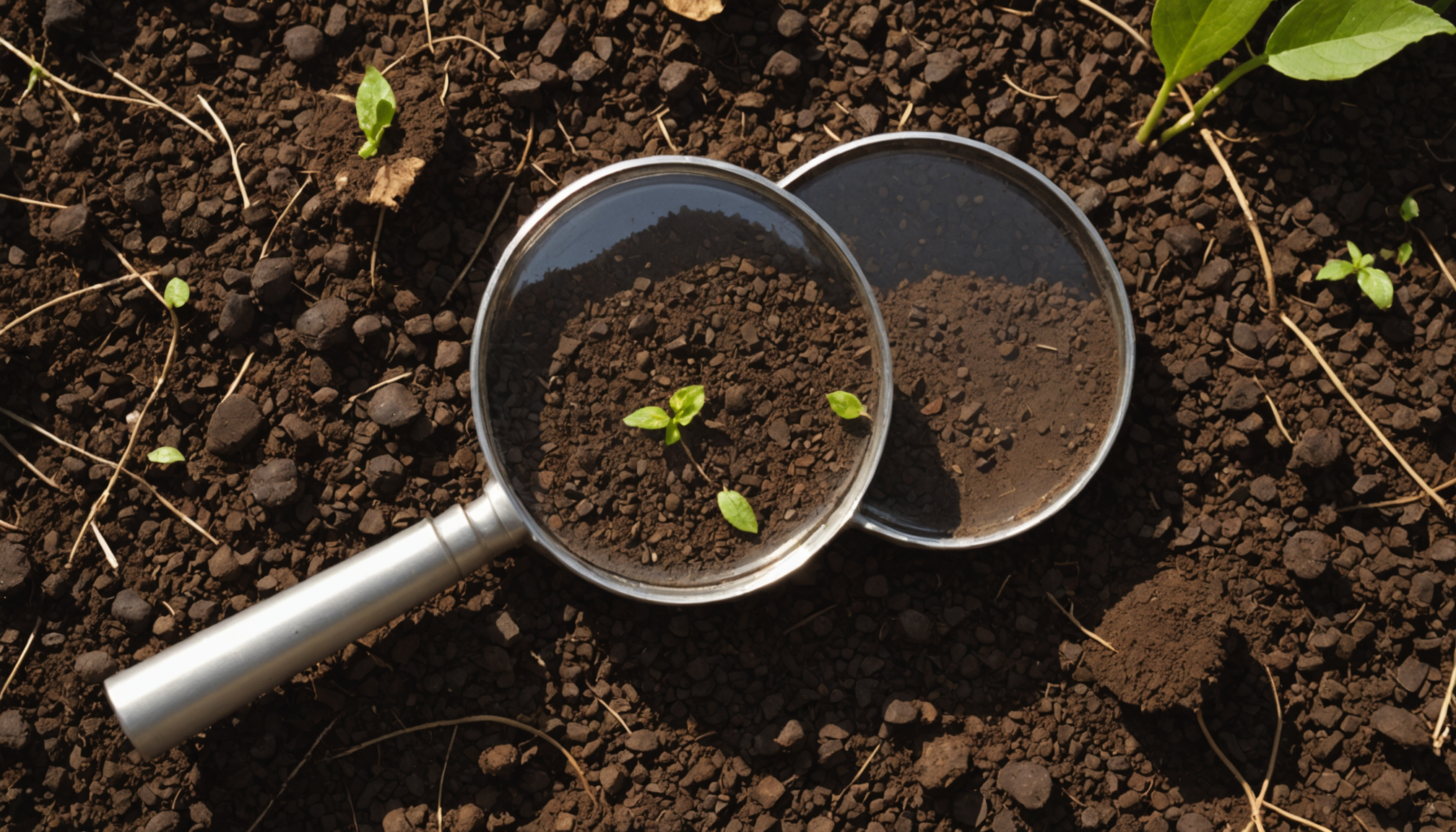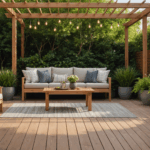When considering how to replace or revamp your garden, one crucial starting point is evaluating the soil quality. Understanding your soil is essential not just for the immediate health of your plants but also for the long-term sustainability and beauty of your garden. Proper soil evaluation will result in a resilient garden that can stand the test of time, adding to the home’s aesthetic appeal and even its resale value. A healthy, well-planned garden can become as valuable as indoor renovations, contributing to a smart home’s overall allure.
Before planting, conduct a thorough soil assessment to identify its type, structure, and nutrient content. This process involves physical observation and, possibly, professional soil testing. Here are the steps to effectively evaluate your soil quality:
- Texture Analysis: Determine whether your soil is sandy, loamy, or clay. Each type has distinct characteristics and suitable applications. Loam, with its balanced texture, is generally preferred for most garden types.
- pH Testing: The soil’s acidity or alkalinity directly impacts nutrient availability and plant growth. Most plants thrive in a pH range of 6.0 to 7.5. A pH test kit from a garden center can simplify this process.
- Nutrient Evaluation: Essential nutrients like nitrogen, phosphorus, and potassium are critical for plant health. Soil tests can identify nutrient deficiencies that need addressing through fertilizers or organic amendments.
- Organic Matter Content: Evaluate the presence of organic matter, which improves water retention, drainage, and provides nutrients as it decomposes. Adding compost can increase organic content efficiently.
Each of these factors contributes to the overall quality of your soil. It’s beneficial to prepare a table to compare the various soil types and their suitability for different plants:
| Soil Type | Texture | Drainage | Plants Best Suited |
| Sandy | Coarse | Excellent | Succulents, lavender, cacti |
| Loamy | Balanced | Good | Most vegetables, grasses, perennials |
| Clay | Fine | Poor | Willow, daylilies, magnolia |
Incorporating these insights will better equip you to choose the right plants, ensuring they flourish in harmony with the existing soil conditions. Additionally, a garden with optimized soil quality is less likely to experience erosion and nutrient runoff, contributing to the larger environmental goals of a smart home ecosystem. By addressing soil quality at the onset, you position your garden to be a low-maintenance, high-impact replacement for outdated, less sustainable landscaping choices, ultimately enhancing the home’s master plan flooring and exterior environment appeal.
selecting suitable plants
Once you have a deep understanding of your soil’s condition, the next step is selecting the right plants that will thrive in those specific conditions. This decision plays a pivotal role not only in the beauty but also in the sustainability of your garden, ultimately enhancing the resale value of your home. The following are essential steps to guide you through selecting suitable plants:
- Identify Your Hardiness Zone: Consult the USDA Plant Hardiness Zone Map to determine which plants are most likely to thrive in your geographical area. Plant hardiness zones are based on the average annual minimum winter temperature, and selecting plants appropriate for your zone will increase their chances of survival and prosperity.
- Determine Plant Requirements: Each plant species has unique needs, including sunlight, water, and soil texture preferences. Use the soil evaluation results you obtained earlier to match these requirements with your garden’s conditions.
- Sunlight Needs: Identify the areas of your garden that receive full sun, partial shade, or deep shade throughout the day. Choose plants accordingly, ensuring sun-loving plants are not placed in shaded sections, and vice versa.
- Watering Requirements: Consider the water availability and the drainage capabilities of your soil. Group plants with similar water needs together to optimize irrigation efforts and resource efficiency.
- Prioritize Native and Drought-Resistant Species: Native plants are adapted to local environmental conditions and require less maintenance, reducing the need for additional water and fertilizers. Similarly, drought-resistant plants contribute to a sustainable garden by minimizing water usage, in line with smart home ecosystems.
- Mix Perennials and Annuals: Incorporating a balance of perennials and annuals can offer year-round visual interest. Perennials will return each year, providing continuity and reducing the need for replanting, while annuals can be used to refresh and change the garden’s appearance with different seasons or trends.
- Plan for Growth and Structure: Consider how large each plant will grow over time. Arrange taller plants behind shorter ones for a visually appealing layered look, and ensure shrubs or trees have adequate space to expand without overcrowding other plants.
- Consider Aesthetic Appeal: Think about the color, texture, and form of each plant. Choose a color palette that harmonizes well with your home’s exterior and flooring, and incorporate a variety of leaf textures and plant forms to create intrigue and diversity within your garden design.
By thoughtfully selecting plants that match your garden’s environmental conditions and design preferences, your garden will not only become a breathtaking feature of your home but also a sustainable and smart choice. This comprehensive approach ensures your garden enhances the overall aesthetic while contributing positively to the eco-friendliness and smart home features, adding significant value and appeal in today’s environmentally-conscious market.
designing garden layout
Creating an effective layout for your garden is both an art and a science, demanding a blend of aesthetic vision with practical planning. The design of your garden layout not only influences how visually appealing your outdoor space will be but also how functional and sustainable it can become over time. A thoughtfully planned garden layout might elevate the resale value of your property while complementing other elements of a smart home, such as energy efficiency and sustainable living.
Begin by considering the purpose and function of your garden. Are you aiming for a peaceful retreat, a vegetable patch for growing your own produce, or perhaps a vibrant, family-friendly space for outdoor entertainment? Pinpointing the primary function will guide you in allocating zones for different features like sitting areas, pathways, and flower beds. This helps in ensuring that the garden is both visually cohesive and aligned with your outdoor lifestyle goals.
Utilizing the principles of balance and symmetry can enhance the aesthetic appeal of your garden. Whether you choose a formal layout with well-defined geometric patterns or a more casual, organic flow, achieving balance either through symmetry or well-distributed plant masses will contribute to an aesthetically pleasing garden. For instance, placing identical elements such as pots or sculptures on either side of a pathway creates symmetry, while balance can also be achieved through distributing plantings and features harmoniously across the garden space, even in asymmetrical designs.
Scale and proportion are also vital considerations. Incorporate a range of plant and structure sizes to create depth and interest. Taller elements like trees or pergolas can provide vertical interest, while shrubs, raised beds, or even garden flooring in the form of stone walkways contribute additional layers. This diversity in height and size directs the eye upward and guides the viewer through the space, providing both intrigue and clarity.
Color and texture add another layer of richness to your garden. Color schemes can unify different areas of the garden. Deciding on a palette beforehand will ensure consistency and harmony. Cool colors like blues and greens can make a space appear larger and more serene, whereas warm reds and yellows create an inviting, energetic atmosphere. Texture, on the other hand, comes into play with the juxtaposition of different plants and materials. The bark of a tree, the shine of a pond, the roughness of stone flooring, or the soft foliage of ground covers each bring unique characteristics that enhance the garden’s sensorial appeal.
Incorporate practical elements like paths, seating, and light fixtures that complement the garden’s design. Well-planned pathways provide both aesthetic structure and functional utility, guiding visitors through the garden in a natural flow. Consider eco-friendly materials, like reclaimed wood or permeable pavers, for these hardscapes to enhance sustainability. Lighting can highlight focal points during evening hours and ensure pathways are safely illuminated, enhancing the usability of the garden post-sunset.
Finally, the concept of sustainability should intersect with every decision made in the design process. Incorporating native plants not only adds beauty but also reduces the need for watering and pest control. Water collection systems can be discreetly integrated, and mulching can improve soil health while reducing water loss. All these measures support the ecological value of your garden, aligning with broader smart home principles.
By taking into account these multifaceted design principles, you can create a garden layout that is not just visually captivating but also a testament to thoughtful, sustainable planning. This holistic approach will ensure that replacing or revamping your garden yields an outdoor haven that complements your home beautifully, meets lifestyle needs, and enhances your property’s overall value.
choosing sustainable materials
When it comes to revamping your garden with sustainability in mind, the choice of materials plays a pivotal role. Opting for sustainable materials can significantly enhance the environmental friendliness and aesthetic appeal of your space, aligning with the larger goals of a smart home. Such choices not only contribute to ecological health but may also boost the resale value of your property by presenting an environmentally responsible and forward-thinking design.
Start by assessing the current materials in your garden and identify areas that need replacement or improvement. Look for eco-friendly alternatives that have a lower environmental impact throughout their life cycle. For example, when selecting materials for garden pathways or patio flooring, consider options like recycled stone, reclaimed wood, or composite materials made from renewable sources. These materials offer durability and a rustic charm while reducing the demand for new raw resources.
Beyond hardscape elements, consider using sustainably-sourced organic mulch, which offers multiple benefits. Organic mulch not only suppresses weeds and retains soil moisture but also enriches the soil as it decomposes, reinforcing the health of your garden naturally. This section of your garden can demonstrate smart home principles by showcasing how thoughtful material choices can lead to both aesthetic and functional improvements.
When it comes to fencing and structural elements, bamboo and other rapidly renewable resources are excellent alternatives. Bamboo grows exceedingly fast compared to traditional timber, providing a robust and appealing fencing option that supports biodiversity and reduces deforestation. Similarly, recycled metal or composite materials can be used for trellises and pergolas, combining strength with environmental consciousness.
Sustainable gardening practices also involve considering your garden’s broader ecological footprint. Implementing permeable pavers or gravel instead of concrete allows rainwater to filter through the ground, reducing runoff and helping to maintain the natural water cycle. Such approaches not only enhance the sustainability of your garden but also contribute to a smart home ecosystem that respects and adapts to natural processes.
For furnishings, explore furniture made from recycled material or sustainably sourced woods. Such pieces not only add comfort and style to your outdoor living space but also reinforce a commitment to environmental stewardship. Look for certifications like FSC (Forest Stewardship Council) or PEFC (Programme for the Endorsement of Forest Certification) when purchasing wooden items to ensure responsible sourcing.
Finally, integrate lighting solutions that reflect your dedication to sustainability. Solar lights or energy-efficient LED fixtures can illuminate your garden beautifully, reducing electricity consumption and enhancing the environmental compatibility of your space. Intelligent lighting systems that can be controlled via smart home technology are a great way to merge convenience with energy conservation.
By thoughtfully selecting sustainable materials, you infuse your garden with eco-friendly practices that elevate both its visual appeal and environmental integrity. This approach not only supports a healthier planet but also reflects positively on your property’s overall charm and resale value, meeting the growing demand for smart and sustainable home features.
implementing smart irrigation systems
Integrating an advanced irrigation system is crucial for creating a garden that is both efficient and environmentally friendly. With ongoing concerns about water conservation and sustainable living, smart irrigation technologies provide a modern solution for maintaining a lush garden while minimizing water waste. These systems can increase the resale value of your property by demonstrating a commitment to sustainability—a feature highly sought after in today’s smart home market.
Start by exploring different types of smart irrigation controllers available in the market. These devices automatically adjust watering schedules based on weather forecasts, soil moisture levels, and even the types of plants in your garden. This precision not only optimizes water use but also ensures that every plant receives the right amount of moisture to thrive. Look for controllers with features that integrate with your existing smart home system, allowing for control through a smartphone app or voice commands for added convenience.
Consider pairing these controllers with soil moisture sensors, which provide real-time feedback on the moisture levels at various depths of your garden. These sensors collaborate with the irrigation system to water only when necessary, promoting deep root growth and robust plant health. This not only conserves water but also fosters a thriving ecosystem within your garden.
Drip irrigation systems are another excellent option, delivering water directly to the roots of plants and reducing evaporation. This efficiency helps to maintain soil structure and avoid unnecessary water runoff. When combined with smart technology, drip systems become even more effective, adjusting flow rates and schedules based on environmental data.
To further enhance the sustainability of your garden, consider collecting rainwater or greywater for irrigation purposes. Installing a rain barrel or an underground tank can capture rainwater from your roof, providing a renewable water source for your garden. An integrated filtration system ensures this water is suitable for plants, while a pump allows seamless integration with the existing irrigation network. Such systems not only reduce dependency on municipal water supplies but also demonstrate innovative ways to align your garden with the principles of a smart home.
By implementing these smart irrigation systems, you replace outdated and inefficient watering methods and showcase a commitment to sustainable landscaping. Such a garden is not only visually appealing but also a testament to the principles of environmental stewardship, a factor that significantly enhances the property’s resale value. With technology on your side, maintaining a beautiful, functional, and green outdoor space becomes both efficient and rewarding.
In conclusion, transforming your garden into a sustainable and smart haven requires thoughtful planning and integration of eco-conscious practices at every stage. From assessing soil quality and plant selection to design layout, sustainable materials, and smart irrigation, each step plays a crucial role in creating an outdoor space that is aesthetically pleasing and environmentally sound. By making these conscious upgrades, you embrace the values of sustainability and forward-thinking design, aligning your garden with the rising demand for smart home features. This comprehensive approach not only enhances your property’s beauty but also its resale value, offering a living testament to your commitment to a healthier planet and a more sustainable lifestyle.


